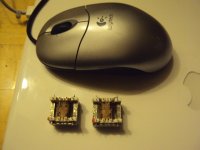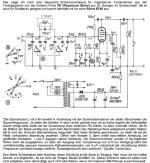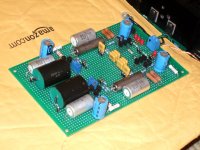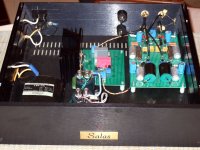I got the Hensler Coils. They are really cute. See the picture compared with a standart computer mouse.One coils is spot on and the other 2% low. I think this is really good if you consider that the 1mH tab has only 50 windings, and 1 winding is already 2% of the total. Windings are made with HF litz wire and dipped in shellac. The whole coils are clued and dipped in scellac too and heated and burned in with current. I will put them in on wednesday and report. DC resistance of the 1mH winding is 0.8Ohm so i am able to finetune with resistance.
Attachments
I have now recovered full from the ETF festival and of cause one of the things i am working on is a phonostage. I bought some very low noise Toshiba N-channel J-Fets recently.
The 2SK170 i use here quite often is by no means the lowest noise J-Fet ever designed.
In fact it is a 30 year old design and technology has moved on since. The main advantage the 2SK170 has, is that it has a P-channel complement and that makes my parallel symmetric open loop stages posible. Parallel symmetric design cancels second harmonic, the major source of distortion in a sigle ended J-Fet stage so low distortion open loop circuits can be build that way. Voltage Noise can be lowered by paralleling using the Faulkner circuit but that does not have a influence on the rather high 1/f frequency of the 2SK170-2SJ74 pair. In praxis noise under 1kHz is higher in a J-Fet circuit then using bipolars. Psychoacoustics help out here because of the Fletcher-Munson curve but the effect is real and measurable. In 2004 Toshiba brought out a new generation of J-Fets that had a much lower 1/f frequency and a higher transconductance of 40mS. Input capacitance did not get up much so it is posible to build a J-Fet input stage with 4 of those in parallel that is even lower in noise under 1kHz then 4 plus 4 of the older generation plus half of the input capacitance. Unfotunately there is no P-channel compliment so i started to think about a low distortion single ended N-channel design. One thing you can do is cascoding and that lowers the distortion much. Examples are the Salas Simplistic, the Pass Pearl or the Aksa Paris. Still this designs do not reach my target of -80dB distortion at 1V out @ 20kHz. Feedback can be used of cause and that is the road i took.
The 2SK170 i use here quite often is by no means the lowest noise J-Fet ever designed.
In fact it is a 30 year old design and technology has moved on since. The main advantage the 2SK170 has, is that it has a P-channel complement and that makes my parallel symmetric open loop stages posible. Parallel symmetric design cancels second harmonic, the major source of distortion in a sigle ended J-Fet stage so low distortion open loop circuits can be build that way. Voltage Noise can be lowered by paralleling using the Faulkner circuit but that does not have a influence on the rather high 1/f frequency of the 2SK170-2SJ74 pair. In praxis noise under 1kHz is higher in a J-Fet circuit then using bipolars. Psychoacoustics help out here because of the Fletcher-Munson curve but the effect is real and measurable. In 2004 Toshiba brought out a new generation of J-Fets that had a much lower 1/f frequency and a higher transconductance of 40mS. Input capacitance did not get up much so it is posible to build a J-Fet input stage with 4 of those in parallel that is even lower in noise under 1kHz then 4 plus 4 of the older generation plus half of the input capacitance. Unfotunately there is no P-channel compliment so i started to think about a low distortion single ended N-channel design. One thing you can do is cascoding and that lowers the distortion much. Examples are the Salas Simplistic, the Pass Pearl or the Aksa Paris. Still this designs do not reach my target of -80dB distortion at 1V out @ 20kHz. Feedback can be used of cause and that is the road i took.
I have now recovered full from the ETF festival and of cause one of the things i am working on is a phonostage. I bought some very low noise Toshiba N-channel J-Fets recently.
The 2SK170 i use here quite often is by no means the lowest noise J-Fet ever designed.
In fact it is a 30 year old design and technology has moved on since. The main advantage the 2SK170 has, is that it has a P-channel complement and that makes my parallel symmetric open loop stages posible. Parallel symmetric design cancels second harmonic, the major source of distortion in a sigle ended J-Fet stage so low distortion open loop circuits can be build that way. Voltage Noise can be lowered by paralleling using the Faulkner circuit but that does not have a influence on the rather high 1/f frequency of the 2SK170-2SJ74 pair. In praxis noise under 1kHz is higher in a J-Fet circuit then using bipolars. Psychoacoustics help out here because of the Fletcher-Munson curve but the effect is real and measurable. In 2004 Toshiba brought out a new generation of J-Fets that had a much lower 1/f frequency and a higher transconductance of 40mS. Input capacitance did not get up much so it is posible to build a J-Fet input stage with 4 of those in parallel that is even lower in noise under 1kHz then 4 plus 4 of the older generation plus half of the input capacitance. Unfotunately there is no P-channel compliment so i started to think about a low distortion single ended N-channel design. One thing you can do is cascoding and that lowers the distortion much. Examples are the Salas Simplistic, the Pass Pearl or the Aksa Paris. Still this designs do not reach my target of -80dB distortion at 1V out @ 20kHz. Feedback can be used of cause and that is the road i took.
I use 60ms 3X grouped hard to get Toshiba parts some times in LMC where it counts most. In my 62.5dB gain LMC they give 10dB improvement in the 1/F region, and higher a bit better also, VS 4XK170 with same group common Rs. Scott Wurcer says its about GR noise mainly in K170's case, not 1/F. Mine is open loop as you know, but I get 0.02% THD with 0.25mV input, and noise floor at -100dB @ 20Hz and -140dB @ 20kHz Ref1V=0dBV so I am content for playing vinyl with such noise and such gain. That is without further local PSU filtering not even RC. Just a common V1.2R reg. I would expect to get better figures even with a local low Z filter for the head amp. Since cascode is sensitive. But in some future build. For now its adequate, to my needs at least. Open loop circuits when technically good enough have something special in their tone and portrayal IMHO.
Attachments
Well, that looks very good. Yes, i have seen SW´s noise measurements and comments about GR noise in the 2SK170.
I usually prefer open loop too but this is a commercial design so the measurments should be better excellent. Unfortunately here in Germany measurements matter much if you aspire to a reference titel. In my stage i use 4 at near Idss so GM should be around 200mS in my case. PSU rejection should be good in my design because i use a constant current source over the input cascode and i feed the second stage with a common mode version of the PSU noise. Kind of Aikido for Opamps. One channel is playing and the other will be ready in a few hours if i have luck. I hope it sounds good too but i will tell you soon.
I usually prefer open loop too but this is a commercial design so the measurments should be better excellent. Unfortunately here in Germany measurements matter much if you aspire to a reference titel. In my stage i use 4 at near Idss so GM should be around 200mS in my case. PSU rejection should be good in my design because i use a constant current source over the input cascode and i feed the second stage with a common mode version of the PSU noise. Kind of Aikido for Opamps. One channel is playing and the other will be ready in a few hours if i have luck. I hope it sounds good too but i will tell you soon.
i found a PDF about GR noise. This is complicated stuff.
http://igitur-archive.library.uu.nl/dissertations/2003-1020-143321/c3.pdf
http://igitur-archive.library.uu.nl/dissertations/2003-1020-143321/c3.pdf
Salas,
What happened to Matisse ?
Audiofanatic
He took a coffee break.
The second channel worked right away and i hope i have the system playing in the next 20 minutes. An all in one go NFB MC phonostage is not trivial to stabilise and i can imagine that many designers give up when open loop is so easy to get stable. The open loop gain is over 120 dB acording to my calculation, leading to a gain of 83dB in the bass and 43 dB in the treble. Fortunately i got a lot of experience with feedback when i designed the FPS for Linear Audio. A combination of lead-lag and Miller compensation gave a nice looking square and the response is very extented up to 340Khz, the first zero in the Lipshitz legacy network. It is interesting to note that a RIAA with such high gain does not need an aditional pole like in the Self Precission Peamp to be acurate over 20kHz because the first pole is shifted very high up. Spare me the mathematics and buy Burkhard Vogels book "The Sound of Silence" for a detailed analysys of this phenomenon.
I got it going and the quietness of this stage is really scary. The system fully cranked up and late at night i can barely hear a sound in the listening space.
At normal volume with ear on speaker i can only hear the faint noise my tube amps make.
Again fully cranked it is obvious that it is less noisy in the deeper regions then my best 2SK170-2SJ74 stages and nobody was complaining about noise in that stages so far.
I can only listen at low volume because my family is in bed so i can tell you more how it sounds tomorrow. I will also reveil some aspects of the schematic although this will not be a full description that makes it posible to copy. People that have followed my thread though will get a good understanding what i try to do.
This stage is only posible with the latest super fast Fet Opamps and Buffers. The Opamp i use has a gain-bandwidth of 140MHz and a slew rate of 180V/usec and the Buffer has a slew of 2000V/usec. It will be hard to build that stage fully discrete so this is one example where Opamps are not only economical but also necesarry.
At normal volume with ear on speaker i can only hear the faint noise my tube amps make.
Again fully cranked it is obvious that it is less noisy in the deeper regions then my best 2SK170-2SJ74 stages and nobody was complaining about noise in that stages so far.
I can only listen at low volume because my family is in bed so i can tell you more how it sounds tomorrow. I will also reveil some aspects of the schematic although this will not be a full description that makes it posible to copy. People that have followed my thread though will get a good understanding what i try to do.
This stage is only posible with the latest super fast Fet Opamps and Buffers. The Opamp i use has a gain-bandwidth of 140MHz and a slew rate of 180V/usec and the Buffer has a slew of 2000V/usec. It will be hard to build that stage fully discrete so this is one example where Opamps are not only economical but also necesarry.



